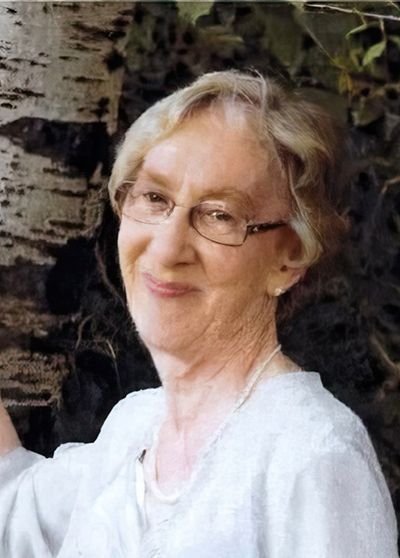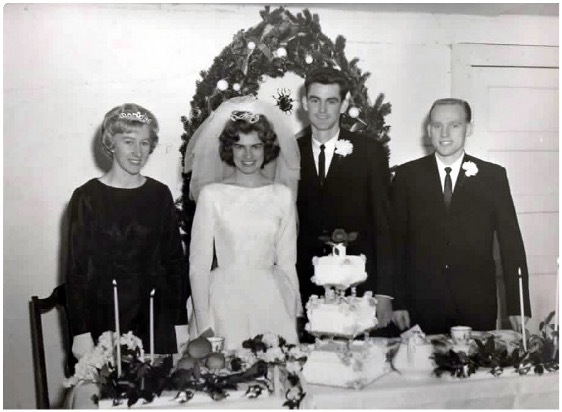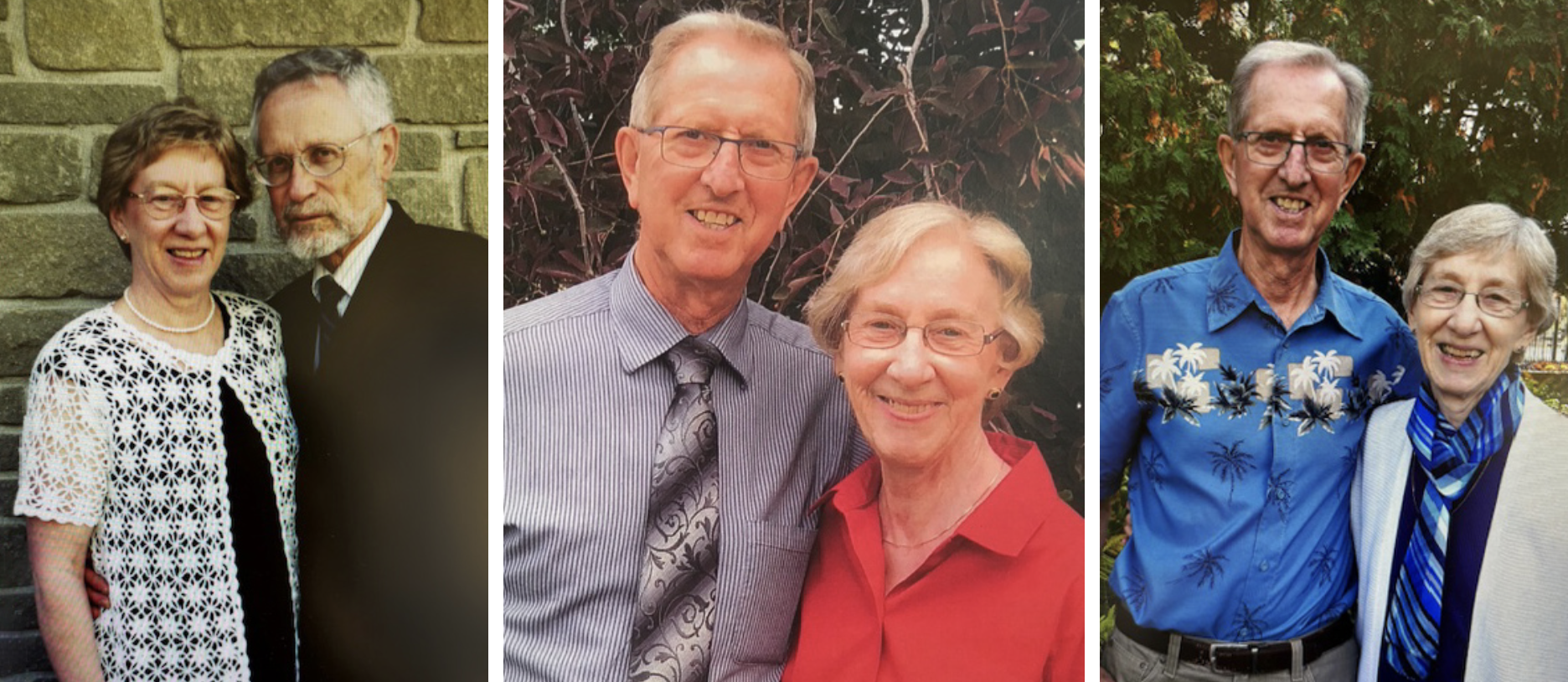First Mennonite Woman in Alberta ordained as a Minister of the Gospel
October 15th
“Ordained Minister” was not among Linda Neufeld’s dreams for a future career.
When she graduated from high school in 1959, she writes:
"I am about to graduate from grade 12. What to do now?"
Well, for young women at this time there seemed to be only three options – nurse, secretary, and teacher.
"The first two had no appeal for me, so (partly by default) I considered teaching. Another factor in weighing my options was that my family was too poor to fund further education. It just so happened that a provincial bursary was available for the one-year program at Teachers’ College. So off I was."

Linda’s father was an unpaid (and where there’s no salary there’s no pension plan) ordained minister in Tofield, AB. Later he became an Elder (Aeltester), which required a second ordination equipping him to do baptisms, lead communion services, and ordain other pastors. To make ends meet, he took various paid jobs, as they became available. One of his specialties was carpentry, but in the bitterly cold Alberta winters of those days, there was less call for this trade, as it was carried out at the time. Also, the responsibilities involved in full-fledged ministry, including positions on various conference-wide committees and boards, in addition to travelling to other churches to do their baptisms, etc., left little time for consistent employment elsewhere. Pastoring was a labour of love. As part of a pastor’s family, Linda did her best to lend a helping hand wherever she could, especially financially. (footnote 1)
Linda taught for a total of 16 years, beginning with three in Tofield, close to home, where she could be a support to her family.
CMBC (Canadian Mennonite Bible College; now CMU – Canadian Mennonite University)
Within her, however, was a longing for something deeper, drawing her beyond the elementary classroom. In the fall of 1962, she became my roommate at CMBC, a gentle, competent, determined student. We got along well. Though Hugo Neufeld and I had not yet had a date, Linda had somehow learned that we had a growing interest in each other, and was eager to tell me that she was Hugo’s second cousin, and that her Dad, like Hugo’s, was a pastor. Our wedding took place a year and a half after I left CMBC, yet Linda agreed to be my bridesmaid (Jake Wiebe was bestman). What she didn’t know at the time was that it would be one of the coldest, snowiest Abbotsford winters on record. Significant travel would be involved. Red was not one of her favourite colours, and velvet was not an easy fabric for her mother to sew, yet Linda agreed that red velvet was a good option for her bridesmaid dress at a Christmas wedding.

After two years at CMBC, Linda worked a year to address her depleted financial resources, as well as those of her parents, but returned for her third year, graduating in 1966.
Pauingassi, Manitoba
Again, something nudged Linda’s heart, when she heard of a need for teachers in Pauingassi, a northern Manitoba First Nations community, accessible only by air. Bush planes landed on nearby Fishing Lake, with pontoons in the summer and skis in the winter. During spring break-up and fall freeze-over, there was no travel in and out of the settlement.
This was a reservation where Henry and Elna Neufeld had already spent many years as workers under Mennonite Pioneer Mission. They and their family were the only Caucasians in the community. Linda and Ruby Enns, a friend from CMBC, spent two years living and working in this community, flying out only for Christmas, and possibly one other time, besides the summer. In addition to seeing family (not always possible), these fly-outs were opportunities to stock up on dried and canned goods, as well as other supplies needed for the long weeks ahead.
Linda’s compassionate spirit was touched by the needs of some of the children. She wrote home to her mother about one of her primary students, who came to school on the coldest of winter days, wearing a flimsy dress with only one button, and nothing but a sweater over it. Linda’s Mom responded by sewing a warm dress for the girl and including a pair of tights for added warmth. Linda gave the gifts to her little student at the end of one day. The next day the girl’s older sister was proudly clothed in the new garb, apparently following a hierarchy where older family members get priority.
Back to Alberta
Following these two challenging (though somehow also fulfilling) years, Linda returned to Alberta, teaching one year in Calgary, before moving on to Okotoks, where she taught elementary school for another ten years. Foothills Mennonite Church in Calgary was her church home. Near the end of those teaching years, Erland Waltner, former president of AMBS (Associated Mennonite Biblical Seminaries) in Elkhart, Indiana, spent several days at the Foothills Church holding deeper life services. ”Do you know if there is anyone in this church who might be interested in attending AMBS?” Waltner asked during one of the breaks. “I don’t know,” someone responded. “But I think maybe Linda Neufeld would be interested.” Linda had never seriously thought about seminary as an option, but the idea began to take root. Soon she received a letter from the seminary, inviting her to study there. To her surprise, it answered a call deep within her. However, she did not reply before consulting with several trusted friends, including two of her uncles, both pastors. The timing was good. She needed a change. Where it would lead, was not yet clear.
The Seminary Experience
With the encouragement of her uncles and other friends, she set out on another diversion from teaching. Thinking she would be attending AMBS for just one year, she chose only the subjects that most appealed to her. The next year she returned to Okotoks “to teach and to fulfill some financial responsibilities,” but returned to the seminary again, this time with more serious intent. That meant she needed to pick up on required courses. “Now,” she says, “some of the courses were quite difficult for me.” (Linda’s sharing at the 50th anniversary of her graduation from CMBC).
She began to think more seriously about the future. Somewhat weary of some aspects of teaching elementary school, she wondered about teaching adults, perhaps in a Bible School setting, but after some testing, decided this was not where her abilities lay. As part of the seminary curriculum, students were required to spend some time in a practical setting, related, if possible, to future employment goals. Though a trifle hesitant, Linda applied for a dynamic 10-week course in Clinical Pastoral Education (CPE) at the Memorial Hospital in South Bend, only a few miles from Elkhart. This experience was so positive, that she took a year-long series of CPE units, after she graduated from AMBS. A plan for the future was taking shape. At last, there was excitement in her heart, as she looked ahead. Ultimately, this choice led to her being hired as a chaplain at the 365-bed Charles Camsell Hospital in Edmonton.
Ordination
When her Foothills pastor, Menno Epp, heard that Linda was working on chaplaincy training, he suggested to her that, to be accepted as chaplain in any hospital, ordination would likely be required. This would not only clarify and confirm her calling, but also place the strength of the Christian community in her support. After a brief preparation period, that included filling out a Ministerial Leadership Information (MLI) form, her character assessment was found to be well matched to her verbal witness. Pastor Menno Epp, and Conference Minister David Braun were involved in her ordination service at the Foothills Mennonite Church, on Linda’s 43rd birthday, November 6, 1983. She was the first Mennonite woman in Alberta to be ordained as a “Minister of the Gospel” An official ordination certificate signed by Rev. John Esau of Newton KS, representing the General Conference Mennonite Church, arrived a few months later, affirming that the strength of the Canada-US constituency was giving its blessing.
Now a Chaplain
In 1984 Linda moved to Edmonton to begin her career as a chaplain at the Charles Camsell Hospital. She also transferred her membership to First Mennonite Church in Edmonton, where she participated fully in all aspects of church life, at various times, singing in the choir, serving on the preaching team, serving as deacon, as Sunday school teacher, and more, as her schedule allowed.
A few years later, to ease provincial budget stress, Premier Ralph Klein, closed that hospital. Fortunately, Linda was able to find employment at the much larger Royal Alexandria Hospital, also in Edmonton. When further provincial budgetary cuts left her with only a half-time position, she was able to obtain another half time position at the Misericordia Hospital. She writes in a presentation at the 50th anniversary of her graduation from CMBC:
I found chaplaincy very fulfilling. It was a privilege to “walk with” patients and their families through their various experiences. And it was good to walk with hospital staff of all disciplines. I was also requested to officiate at funerals – particularly of people who had no church home, but their families wished a religious service. (She is said to have officiated at more than 80 funerals). I also officiated at some weddings.
A notable first (and last?) for her was to be asked to lead an exorcism, in one of the Intensive Care Unit cubicles, where three deaths had occurred on three consecutive days, and staff were refusing to work there – until something was done.
Retirement
Linda had dreamed of retiring at 60 years of age. If she was thinking that would give her 20 years of relaxing, going on trips with friends, reading books, joining book clubs, and doing volunteer work here and there, she had a surprise coming. Within 20 years, she had been ushered into two family circles, totaling 19 people who became “next-of-kin” to her, including all the joys and challenges of family life.
Marriage
”In 1999, before Linda’s retirement began, Katherine Buhr, a friend and fellow church member, was dying of cancer. Though Katherine was not in one of the hospitals in which Linda was employed, she drew on her many years of experience as she ministered to Katherine in ways that were meaningful to both Katherine, and her husband, Lorne.
Almost two years after Katherine’s death, Lorne, a librarian at the Alberta Legislative building, invited Linda to be his wife. By accepting his proposal, Linda became part of a family circle that included Lorne’s three young adult sons, one of them married, with a new-born son. Another daughter-in-law joined the family later, as did a granddaughter. The family continued an established practice of all getting together for dinner once each week, just before choir practice. Lorne and Linda also did weekly childcare for the two little ones. As her daughter-in-law, Ev, puts it, Linda entered the family with her usual “quiet grace and a determination to make this all work.”
There were many good times; family gatherings, trips with Lorne, one of them to Brazil and Paraguay, where they had the privilege of attending Mennonite World Conference in Asuncion.
Sadly, the “Golden Years” did not last. Despite Linda’s tender support and Lorne’s determination to fight his Parkinson’s diagnoses with all his energy, he ultimately needed a Care Home, when his physical and mental energies gave out. Linda made it a point to spend a generous portion of each day with him, until he died in October, 2016.
Both Katherine and Lorne, who married in 1965, had been Linda’s friends since CMBC days.
Another Marriage
Linda had actually had a date or two with another CMBC friend, Hugo Peters, while at college, but nothing more than that had materialized. In 1964 Hugo married Herta, another CMBC student. After Herta’s death less than 3 weeks after Lorne’s passing, Hugo, a retired Winnipeg high school teacher, eventually began to wonder about Linda. Soon he began renewing connections from more than 50 years back. In 2018 they were married in a “small, family-size” ceremony in Edmonton, before ultimately moving to Winnipeg. There Hugo’s 2 daughters, their spouses, and 5 young adult grandsons, welcomed her into another family circle. She also maintained a connection with Lorne’s family.
Health Issues
When Hugo Peters invited Linda to be his wife, she showed interest but alerted him to the fact that she had for some years been dealing with a brain tumor that had been recurring every 6 years. In 2012 it was removed by surgery; in 2018 by Gamma Knife, a less invasive method. She was left under no illusion that the removal was permanent. It could, realistically occur again. Hugo listened with care and then decided that he would take the risk. After spending some months in Edmonton, dealing with transition tasks, they moved to Hugo’s condo in Winnipeg.
True to its randomly established cycle, the tumor returned with a vengeance in May of 2024. The grim prognosis was that nothing could be done. Final goodbyes were in order. She would not leave the hospital in her own strength. Would she even regain consciousness? When we called her at the hospital a few days later, she surprised us by speaking a gentle, heartfelt message: “Greetings, Hugo and Doreen, God bless you!” After 3 weeks in the hospital, she went back home, until 3 days before her death on September 16, 2024. She was given another 4 months of grace. A gentle dedicated, faithful servant in so many ways, faced the challenges of life and death with a deep, steadfast dedication to her loved ones and to God!
Just as Linda had faithfully nurtured Lorne during his difficult final years, Hugo offered her the same loving care and attention she needed, as she moved toward the end of her earthly journey!
Notes – Based on Linda’s written stories; Linda’s verbal stories recorded by Hugo Peters; Conversations with Hugo Peters, Ev Buhr, Dan Neufeld, Gerry Neufeld, Rachel Siemens, Irene Baergen; Author’s memories.
Irene Klassen, ed., Their Mark: Their Legacy (Calgary, AB: Mennonite Historical Society, 2006), from Linda Neufeld’s article, pp. 34-37.
[1] Irene Klassen, ed., Their Mark: Their Legacy (Calgary, AB: Mennonite Historical Society, 2006), from Linda Neufeld’s article, pp. 34 – 37.
